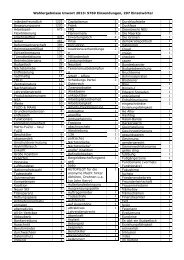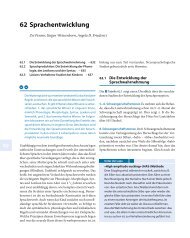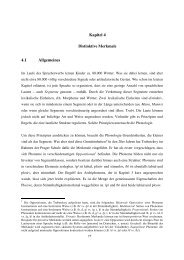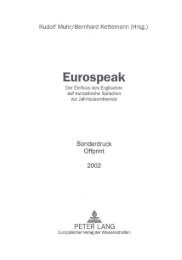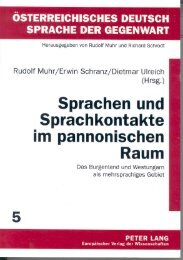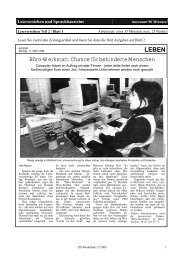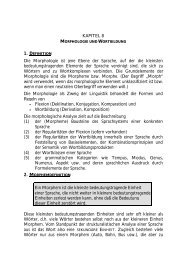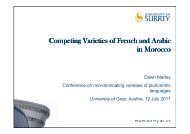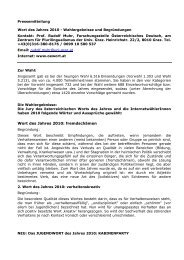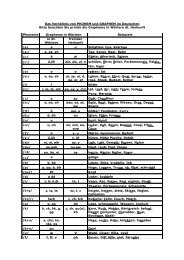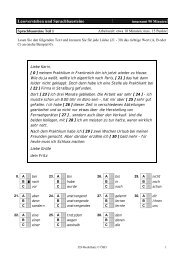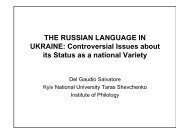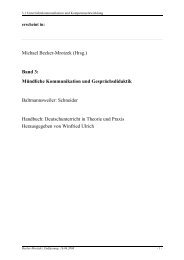Abderrazzaq Msellek
Abderrazzaq Msellek
Abderrazzaq Msellek
Create successful ePaper yourself
Turn your PDF publications into a flip-book with our unique Google optimized e-Paper software.
1<br />
Sociolinguistic aspects of Moroccan Arabic<br />
<strong>Abderrazzaq</strong> <strong>Msellek</strong><br />
University of Fès/Morocco<br />
1. Status of Moroccan Arabic (MA)<br />
2. Communicative function of MA<br />
3. Domains of use and realization forms of MA<br />
4. Sociolinguistic and linguistic features of MA<br />
5. The future of MA<br />
During my talk, I attempt to give a systematic sociolinguistic description of<br />
Moroccan Arabic as a non-dominant variety of Arabic in Morocco. The status,<br />
communicative function, and the domains of use of Moroccan Arabic in<br />
Moroccan society will be especially accentuated. The main hypothesis is that<br />
MA is a spoken language that is used in informal communicative situations of<br />
all communicative domains, in opposite to some available descriptions leading<br />
us to believe that MA is used just in some domains.<br />
Before giving how MA is used by native speakers for different kinds of<br />
communicative purpose, I want first of all to show which languages co-exist in<br />
Morocco. The linguistic situation in Morocco is often characterized as complex.<br />
Then, as has been pointed out, there are four languages used: Standard Arabic,<br />
Moroccan Arabic, Berber, and French; in addition to other foreign languages<br />
that know a positive Evolution in Education, Business and Tourism like English,<br />
Spanish and German. This complexity can be interpreted as a linguistic diversity<br />
or simply as multilingualism that is a major characteristic of Moroccan society 1 .<br />
Concerning the communicative function of each language, Ennaji wrote the<br />
following sentences:<br />
“These Languages (SA, MA, and Berber) do not fulfill all the linguistic<br />
functions, since each one covers only a limited number of domains. For<br />
instance, MA and Berber cover the domains of home and street, while SA is<br />
used in education, public administration, and the media. French is utilized to<br />
complement the picture, as it hat functions and domains with overlap with those<br />
of SA, in addition to covering the private sector, science, and technology.” 2<br />
1 Ennaji, Moha : Multilingualism, cultural identity, and education in Morocco.<br />
2005 Springer Science+Business Media, New York, p: 2<br />
2 Ennaji, Moha : Multilingualism, cultural identity, and education in Morocco.
2<br />
Is it true that MA is a just language of home and street? Or there are other<br />
communicative domains that MA also covers? I’ll give The answer of this<br />
questions , when I first illustrate the status of MA.<br />
1. Status of Moroccan Arabic<br />
In opposite to Standard Arabic that is the official Language of Morocco since<br />
the independence and Berber that become official Language as SA in the last<br />
constitution, Moroccan Arabic is considered as an unofficial Language. Then<br />
MA is a language of everyday conversation which is neither codified nor<br />
standardized, in contrast to SA that is codified, standardized and a written<br />
language. Additionally, MA” is not a homogeneous language in form, as<br />
various Moroccan Arabic dialects are spoken in various geographical areas of<br />
Morocco.” 3<br />
2. Communicative function of Moroccan Arabic<br />
Moroccan Arabic is usually used to express basic needs and everything the<br />
Moroccan people every day does: bay something, make a reservation,<br />
change money at the bank etc. This means that MA is only the expression<br />
side of language used. The other side is the side of the content expressed.<br />
Thus, Moroccan Arabic builds the social and geographic dimension of<br />
Arabic in Morocco. Coupled with functional dimension it gives us that what<br />
we can call Moroccan Arabic for every day or Moroccan everyday-language.<br />
Everyday life can be also dialectal expressed. Moroccan Dialects are spoken<br />
in cities, villages, and in mountains. They are local and too limited, in<br />
Opposite to Moroccan Arabic that is regional and considered as lingua<br />
franca. This means that Moroccan Arabic is not only everyday-Language, but<br />
it expresses various contents from other domains like domain of literature,<br />
business, religion, sport etc.<br />
3. Domains of use and realization forms of Moroccan Arabic<br />
The domains of use of MA, as has been pointed out, are many and different:<br />
a wide spectrum that begins with everyday life and ends with economy,<br />
science, philosophy, religion, literature, and law. The following diagram can<br />
explain this fact very clearly:<br />
2005 Springer Science+Business Media, New York, p: 2<br />
3 Sadiqi, Fatima: Women, Gender, and language in Morocco.<br />
Brill, Leiden – Boston 2003, p: 48
This Diagram shows us particularly two things:<br />
3<br />
1. Moroccan Arabic is not only used in everyday life, but it is used in almost all<br />
communicative areas. We can therefore speak from Moroccan everyday<br />
language, Moroccan religious language, Moroccan literary language etc as<br />
realization forms of Moroccan Arabic.<br />
2. Because Moroccan Arabic is a spoken and not official language, there are<br />
only some text types written of Moroccan Arabic using the Arabic script,<br />
particularly some literary texts, media texts with satire content, and of course<br />
texts expressing everyday life.
4. Sociolinguistic and linguistic Features of Moroccan Arabic<br />
Sociolinguistic characteristics of Moroccan Arabic can be summarized as<br />
follows:<br />
- MA is the low variety of Arabic<br />
- It is a not prestigious Language<br />
- It is the predominant spoken Language in Morocco<br />
- It is used in informal communicative situations<br />
- It is associated with day-to-day activities<br />
- It is not codified, not institutionalized and not standardized.<br />
- Although it is particularly used at home and in the street, Moroccan<br />
Arabic can also express the contents of different domains of use.<br />
Now if we want to treat the linguistic Features of Moroccan Arabic, we can say<br />
that MA has, compared with Standard Arabic, great differences that we would<br />
like to explain as follows:<br />
According to Ennaji’s study, MA has a regular phonology, a simple<br />
morphology, an abundant lexicon, and a great variety of styles. 4<br />
Phonology<br />
4<br />
The sound system of MA differs from that of SA in that MA has five short<br />
vowels and three long ones, while SA has only three short vowels and three long<br />
ones. The influence of foreign language, especially French, on MA is here<br />
visible. Then the two vowels /e/ and /o/ are to find in French loan as /militer/ or<br />
/gome/. In contrast to SA, MA has the consonants /p, v, g/ which shows once<br />
more the result of language contact between MA and French. Otherwise, SA and<br />
MA have generally the same inventory of phonemes and distinctive features. 5<br />
Morphology<br />
MA lacks the dual and the feminine dual and plural forms that SA contents. MA<br />
is less complex in inflection Than SA.<br />
Syntax<br />
SA has basically a Verb-Subject-Object order. MA has a dominant Subject-<br />
Verb-Object order. The word order in MA is not so restricted as in SA.<br />
4 Ennaji, Moha : Multilingualism … P : 60.<br />
5 Ennji p : 61
Lexicon<br />
5<br />
MA is much influenced by SA lexicon. The structure of a lot of words in MA<br />
shows clearly the influence of Berber. For example, a number of MA nouns take<br />
the Berber feminine discontinuous affix t…t or ta….t as in taxaddart, tabaqqalt.<br />
These terms express a state, an action or an occupation. 6 MA uses also many<br />
Berber loan words.<br />
5. The future of Moroccan Arabic<br />
Is MA in fact “ eine Sprache im Werden”? Is it envisaged and possible that MA<br />
one day became a Standard language that we will speak from Standard<br />
Moroccan? Or has MA really no chance against Standard Arabic?<br />
There are two reasons for the negative answer to these questions:<br />
1. The diglossial situation in Morocco implicates that we have a high variety<br />
and a low variety from Arabic. SA is the high variety und MA is the low<br />
variety. I don’t see und also understand how and why the low variety will<br />
be standardized und codified. I think SA and MA are structural different,<br />
but they are in the same time communicative value equivalent.<br />
2. SA that embodies a great literary tradition and is always associated with<br />
Islam and its holy book ” is revered by rich, poor, educate and illiterate<br />
alike as the linguistic jewel in the Islamic cultural patrimony. It is<br />
regarded as the inimitable apogee of perfection, unsurpassable in beauty,<br />
an ethereal ideal of eloquence, perfect symmetry, and succinctness. 7<br />
Ennaji argue that Moroccans consider in fact SA as a prestigious language<br />
and the only form worth learning in schools, and MA a corrupt and vulgar<br />
dialect 8 .<br />
This strong relationship between Moroccans and SA lead me to believe<br />
that MA has really no chance to be codified and standardized. MA will<br />
stay the predominant spoken Language that is particularly used in<br />
informal settings and in everyday activities.<br />
6 Ennaji p : 86<br />
77 Holes, Clive : Modern Arabic<br />
2004, Georgetown University Press , p: 5<br />
8 Ennaji ; p : 69



